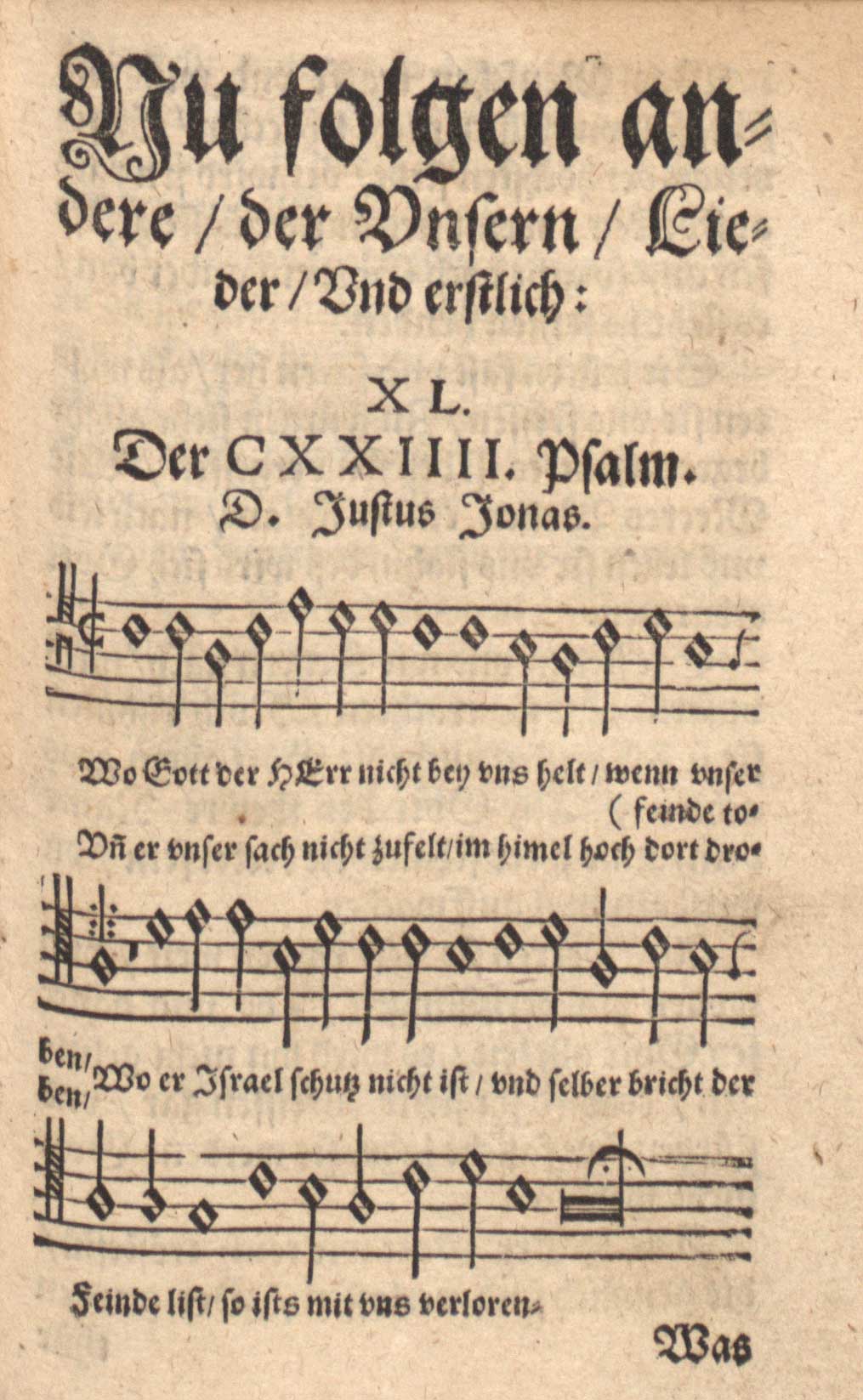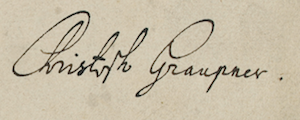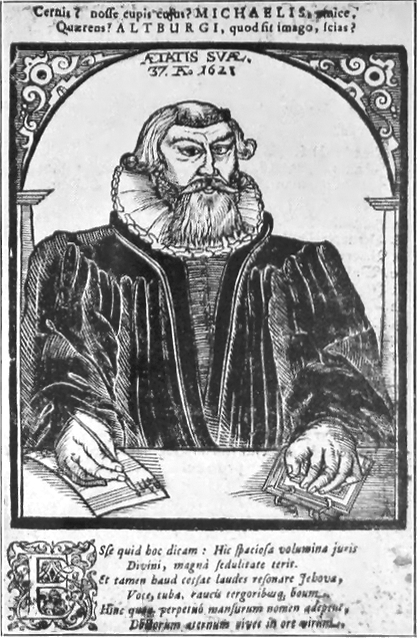|
Wo Gott Der Herr Nicht Bei Uns Hält
"" (, original: ) is a Lutheran hymn by Justus Jonas, a paraphrase of Psalm 124 in eight stanzas. It was first published in 1524 in the Erfurt ''Enchiridion''. The theme of the psalm is the need of help against raging enemies. It has been translated also as "Where the Lord God does not stand (stay) with us", "If God the Lord is not with us", "If God the Lord is not on our side", among others. History Jonas wrote the hymn on a request by Martin Luther in 1524. He combined the ideas of Psalm 124 with passages from Psalm 12 and other Biblical motifs. The text was first published in the Erfurt ''Enchiridion'', a hymnal of 26 songs including 18 by Luther, "Es ist das Heil uns kommen her" and other hymns by Paul Speratus, "" by Elisabeth Cruciger, and others. Luther himself published his own paraphrase of Psalm 124 in three stanzas, ". The current German Protestant hymnal ' has as EG 297 a combination of Jonas' stanzas 1, 2, 5 and 6, and Luther's 2 and 3 (as 3 and 4). Music A hy ... [...More Info...] [...Related Items...] OR: [Wikipedia] [Google] [Baidu] |
Lutheran Hymn
Martin Luther was a great enthusiast for music, and this is why it forms a large part of Lutheran services; in particular, Luther admired the composers Josquin des Prez and Ludwig Senfl and wanted singing in the church to move away from the ''ars perfecta'' (Catholic Sacred Music of the late Renaissance) and towards singing as a ''Gemeinschaft'' (community). Lutheran hymns are sometimes known as chorales. Lutheran hymnody is well known for its doctrinal, didactic, and musical richness. Most Lutheran churches are active musically with choirs, handbell choirs, children's choirs, and occasionally change ringing groups that ring bells in a bell tower. Johann Sebastian Bach, a devout Lutheran, composed music for the Lutheran church: more than half of his over 1000 compositions are or contain Lutheran hymns. History Lutheran hymnals include: * ''Achtliederbuch'', a.k.a. the first Lutheran hymnal (1524). Contains, among others, "Nun freut euch, lieben Christen g'mein", "Es ist das ... [...More Info...] [...Related Items...] OR: [Wikipedia] [Google] [Baidu] |
Johann Walter
Johann Walter, also known as ''Johann Walther'' or ''Johannes Walter'' (original name: ''Johann Blankenmüller'') (1496 – 25 March 1570) was a Lutheran composer and poet during the Reformation period. Life Walter was born in Kahla, in present-day Thuringia, in 1496. According to a document filed with his will, he was born with the surname of Blanckenmüller, but adopted out of poverty by a citizen of Kahla, and given an education at Kahla and Rochlitz under his new name: Johann Walter. He began his career as a composer and bass cantor in the chapel of Frederick the Wise at the age of 21. It was a position he would hold until Frederick's death in 1525. By this time, he was the director of the chapel and had become an outspoken musical spokesman for Lutherans. Walter edited the first Protestant hymnal for choir, ', in Wittenberg in 1524, with a foreword by Martin Luther himself; and for the German-language Deutsche Messe produced in 1527. Following the conclusion of his appointme ... [...More Info...] [...Related Items...] OR: [Wikipedia] [Google] [Baidu] |
BWV2a
Johann Sebastian Bach's vocal music includes cantatas, motets, masses, Magnificats, Passions, oratorios, four-part chorales, songs and arias. His instrumental music includes concertos, suites, sonatas, fugues, and other works for organ, harpsichord, lute, violin, viola da gamba, cello, flute, chamber ensemble and orchestra. There are over 1000 known compositions by Bach. Nearly all of them are listed in the ' (BWV), which is the best known and most widely used catalogue of Bach's compositions. Listing Bach's compositions Some of the early biographies of Johann Sebastian Bach contain lists of his compositions. For instance, his obituary contains a list of the instrumental compositions printed during the composer's lifetime, followed by an approximate list of his unpublished work. The first separately published biography of the composer, by Johann Nikolaus Forkel, follows the same approach: its ninth chapter first lists printed works (adding four-part chorales which h ... [...More Info...] [...Related Items...] OR: [Wikipedia] [Google] [Baidu] |
Kleine Ausgabe – Nach Der Von Wolfgang Schmieder Vorgelegten 2
Kleine is a German and Dutch surname meaning "small". Notable people with the surname include: * Andrea Kleine (born 1970), American writer, choreographer, and performance artist * Christian Kleine (born 1974), German musician and DJ * Cindy Kleine (born ), American film director, producer and video artist * George Kleine (1864–1931), American film producer and pioneer * Hal Kleine (1923–1957), American baseball pitcher * Joe Kleine (born 1962), American basketball player * Lil' Kleine (born 1994), stage name of Jorik Scholten (born 1994), Dutch rapper * Megan Kleine (born 1974), American swimmer * Piet Kleine (born 1951), Dutch speed skater * Robert Kleine (born 1941), American Michigan State Treasurer * Theodor Kleine (1924–2014), German sprint canoer * Thomas Kleine (born 1977), German football defender and manager See also * Klein (surname) * Kleijn Kleijn is a Dutch surname meaning "small". The ij digraph is often replaced with a "y" (''Kleyn''). [...More Info...] [...Related Items...] OR: [Wikipedia] [Google] [Baidu] |
Heinrich Schütz
Heinrich Schütz (; 6 November 1672) was a German early Baroque composer and organist, generally regarded as the most important German composer before Johann Sebastian Bach, as well as one of the most important composers of the 17th century. He is credited with bringing the Italian style to Germany and continuing its evolution from the Renaissance into the Early Baroque. Most of his surviving music was written for the Lutheran church, primarily for the Electoral Chapel in Dresden. He wrote what is traditionally considered the first German opera, ''Dafne'', performed at Torgau in 1627, the music of which has since been lost, along with nearly all of his ceremonial and theatrical scores. Schütz was a prolific composer, with more than 500 surviving works. He is commemorated as a musician in the Calendar of Saints of some North American Lutheran churches on 28 July with Johann Sebastian Bach and George Frideric Handel. Early life Schütz was born in Köstritz, the eldest son of C ... [...More Info...] [...Related Items...] OR: [Wikipedia] [Google] [Baidu] |
Johann Hermann Schein
Johann Hermann Schein (20 January 1586 – 19 November 1630) was a German composer of the early Baroque era. He was Thomaskantor in Leipzig from 1615 to 1630. He was one of the first to import the early Italian stylistic innovations into German music, and was one of the most polished composers of the period. Biography Schein was born in Grünhain. On the death of his father, Schein moved to Dresden where he joined the choir of the Elector of Saxony as a boy soprano. In addition to singing in the choir, he received a thorough musical training with Rogier Michael, the ''Kapellmeister,'' who recognized his extraordinary talent. From 1603 to 1607 he studied at Pforta, and from 1608 to 1612 attended the University of Leipzig, where he studied law in addition to liberal arts. Upon graduating, he was employed briefly by Gottfried von Wolffersdorff as the house music director and tutor to his children; later he became ''Kapellmeister'' at Weimar, and shortly thereafter became Thomaskant ... [...More Info...] [...Related Items...] OR: [Wikipedia] [Google] [Baidu] |
Christoph Graupner
Christoph Graupner (13 January 1683 – 10 May 1760) was a German composer and harpsichordist of late Baroque music who was a contemporary of Johann Sebastian Bach, Georg Philipp Telemann and George Frideric Handel. Life Born in Hartmannsdorf near Kirchberg in Saxony, Graupner received his first musical instruction from his uncle, an organist named Nicolaus Kuester. Graupner went to the University of Leipzig where he studied law (as did many composers of the time) and then completed his musical studies with Johann Kuhnau, the cantor of the Thomasschule (St. Thomas School). In 1705, Graupner left Leipzig to play the harpsichord in the orchestra of the Hamburg Opera under the direction of Reinhard Keiser, alongside George Frideric Handel, then a young violinist. In addition to playing the harpsichord, Graupner composed six operas in Hamburg, some of them in collaboration with Keiser, a popular composer of operas in Germany. In 1709, Graupner accepted a post at the court of Hess ... [...More Info...] [...Related Items...] OR: [Wikipedia] [Google] [Baidu] |
Michael Altenburg
Michael Altenburg (27 May 1584 – 12 February 1640) was a German theologian and composer. Altenburg was born at Alach, near Erfurt. He began attending school in Erfurt in 1590; he began studying theology at the University of Erfurt in 1598, and was awarded a bachelor's degree in 1599 and a master's in 1603. From 1600 he taught at the ''Reglerschule'' in Erfurt; he was Kantor at St. Andreas from 1601 and rector of the school at St. Andreas in Erfurt from 1607. In 1609 he quit teaching to become a pastor, moving to Tröchtelborn and preaching there until 1621. During this period Altenburg published music, and was compared to Orlando di Lasso. After 1621 he moved to Sömmerda, working at the ''Bonifaciuskirche''. While he continued to publish and was respected for his compositions, the Thirty Years War sapped his efforts. In 1636 a massive plague wiped out most of his congregation, and his wife and ten of his children died before himself. He returned to Erfurt in 1637, where ... [...More Info...] [...Related Items...] OR: [Wikipedia] [Google] [Baidu] |
Johann Pachelbel
Johann Pachelbel (baptised – buried 9 March 1706; also Bachelbel) was a German composer, organist, and teacher who brought the south German organ schools to their peak. He composed a large body of sacred and secularity, secular music, and his contributions to the development of the chorale prelude and fugue have earned him a place among the most important composers of the middle Baroque music, Baroque era. List of compositions by Johann Pachelbel, Pachelbel's music enjoyed enormous popularity during his lifetime; he had many pupils and his music became a model for the composers of south and central Germany. Today, Pachelbel is best known for the Pachelbel's Canon, Canon in D; other well known works include the Chaconne in F minor (Pachelbel), Chaconne in F minor, the Toccata in E minor for organ, and the ''Hexachordum Apollinis'', a set of keyboard Variation (music), variations. He was influenced by southern German composers, such as Johann Jakob Froberger and Johann Caspar ... [...More Info...] [...Related Items...] OR: [Wikipedia] [Google] [Baidu] |
Johann Christoph Bach
Johann Christoph Bach (baptised – 31 March 1703) was a German composer and organist of the Baroque period. He was born at Arnstadt, the son of Heinrich Bach, Johann Sebastian Bach's first cousin once removed and the first cousin of J.S. Bach's father, Johann Ambrosius Bach. He was also the uncle of Maria Barbara Bach, J. S. Bach's first wife and second cousin. Johann Christoph married Maria Elisabeth Wiedemann in 1667. They had seven children, including four sons who became musicians: Johann Nicolaus (10 October 1669 – 4 November 1753), Johann Christoph Jr. (29 August 1676 – 1738), Johann Friedrich (1682–1730), and Johann Michael (1685–unknown). He is not to be confused with Johann Sebastian Bach's son, Johann Christoph Friedrich Bach. Johann Christoph had a reputation as a composer that was only equalled by that of Johann Sebastian within the Bach family during his lifetime. He was organist at Eisenach and later a member of the court chamber orchestra there ... [...More Info...] [...Related Items...] OR: [Wikipedia] [Google] [Baidu] |
Wo Gott Der Herr Nicht Bei Uns Hält, BWV 1128
''Wo Gott der Herr nicht bei uns hält'' is a chorale fantasia for organ composed by Johann Sebastian Bach in the early 18th century, likely between 1705 and 1710. The Zahn 4441a hymn tune for Justus Jonas's 1524 hymn "Wo Gott der Herr nicht bei uns hält", a paraphrase of Psalm 124 ("If it had not been the Lord who was on our side ..."), is the basis of the composition. A copy of the chorale fantasia resurfaced on 15 March 2008 at an auction of items from the collection of the 19th-century Bach scholar Wilhelm Rust. The piece, until then known as , could by this discovery be authenticated as Bach's and was reassigned the number BWV 1128. Context In the late 17th century, when he was not yet 15, Bach was already acquainted with the chorale fantasia genre, by such settings as Buxtehude's ''Nun freut euch, lieben Christen g'mein'', BuxWV 210, and Reincken's ''An Wasserflüssen Babylon''. Apart from ''Wo Gott der Herr nicht bei uns hält'', there is only one other kno ... [...More Info...] [...Related Items...] OR: [Wikipedia] [Google] [Baidu] |
Bach's Second Cantata Cycle
Johann Sebastian Bach's chorale cantata cycle is the year-cycle of church cantatas he started composing in Leipzig from the first Sunday after Trinity in 1724. It followed the cantata cycle he had composed from his appointment as Thomaskantor after Trinity in 1723. Bach's second cantata cycle is commonly used as a synonym for his chorale cantata cycle, but strictly speaking both cycles overlap only for 40 cantatas. Two further chorale cantatas may belong to both cycles: the final version of , and the earliest version of ; it is, however, uncertain whether these versions were first presented in Bach's second year in Leipzig. Bach composed a further 13 cantatas in his second year at Leipzig, none of them chorale cantatas, although two of them became associated with the chorale cantata cycle. After his second year in Leipzig, he composed at least eight further cantatas for inclusion in his chorale cantata cycle. Around the start of the Bach Revival in the 19th century, almost no manu ... [...More Info...] [...Related Items...] OR: [Wikipedia] [Google] [Baidu] |








